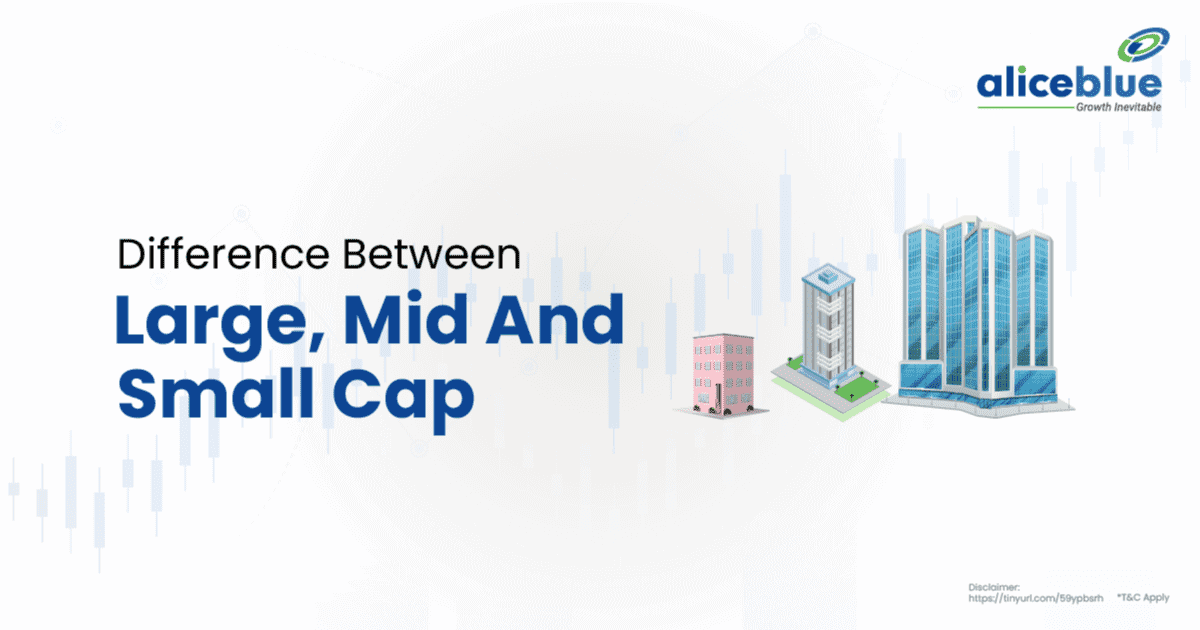The main difference between large, mid, and small-cap stocks lies in company size and market capitalization. Large-caps are well-established companies with high market caps, mid-caps are medium-sized with moderate growth and risk, and small-caps are emerging firms with higher growth potential but increased risk.
Content:
- What Is a Large Cap Stock
- What Is Mid Cap Stocks In India?
- What Is a Small Cap Stock
- Difference Between Large Cap, Mid Cap And Small Cap
- Difference Between Large, Mid And Small Cap – Quick Summary
- Small Cap Vs Mid Cap Vs Large Cap – FAQ
What Is a Large Cap Stock
A large-cap stock represents a company with a high market capitalization, typically ₹20,000 crores and more. These are well-established, financially stable companies and are considered safer investments. Large-cap stocks often pay regular dividends and show less volatility compared to smaller companies.
Large-cap stocks come from well-established companies with strong market presence and stability. Known for their size and stability, they often have a long history of profitability and are usually leaders in their industries.
These stocks are favored by conservative investors due to their lower volatility and potential for steady dividend payouts. While they may offer lower growth rates compared to smaller caps, large-cap stocks provide a solid foundation for a diversified investment portfolio, especially in turbulent market conditions.
For example: Investing in Reliance Industries Limited, with a market cap of over ₹1,300,000 crores, is an example of a large-cap stock. It’s a well-established company, offering stability and potential dividends to shareholders.

What Is Mid Cap Stocks In India?
Mid-cap stocks are shares of medium-sized companies, typically with market capitalizations ranging from ₹5,000 crores to ₹20,000 crores. These companies offer a balance between the stability of large-caps and the growth potential of small-caps, with moderate risk and return potential.
Mid-cap stocks in India represent companies that are not as large as blue-chips but are bigger than smaller startups. They are often in the growth phase, expanding their business operations and market presence.
These stocks blend the growth potential of small-caps with the relative stability of large-caps. While they carry more risk than large-cap stocks, they typically offer higher growth opportunities, making them appealing to investors seeking a balance between risk and potential returns.
What Is a Small Cap Stock
A small-cap stock is associated with a company having a relatively small market capitalization, typically less than 5000 crores in India. These stocks are from emerging or fast-growing companies, offering high growth potential but also higher risk and volatility.
Small-cap stocks are from companies with smaller market values, often new or in early growth stages. They present opportunities for significant growth, appealing to investors seeking high return potential from emerging businesses or niche markets.
However, these stocks carry higher risks due to their susceptibility to market volatility and limited resources. They can be more prone to business challenges and economic fluctuations, making them a more speculative investment compared to larger, more established companies.
Example of a small-cap stock could be investing in a company like Burger King India, with a market capitalization around ₹4,500 crores. These stocks offer growth potential but come with higher risks and volatility.
Difference Between Large Cap, Mid Cap And Small Cap
The main difference is that large-cap stocks are from well-established, high market cap companies, mid-cap stocks from medium-sized firms with moderate growth, and small-cap stocks from smaller, emerging companies with higher growth potential but greater risk and volatility.
| Criteria | Large-Cap Stocks | Mid-Cap Stocks | Small-Cap Stocks |
| Market Cap | Typically above ₹20,000 crores. | Ranges from ₹5,000 crores to ₹20,000 crores. | Generally less than ₹5,000 crores. |
| Company Size | Well-established, large companies. | Medium-sized, often in growth phase. | Smaller, emerging companies. |
| Risk Profile | Lower risk, stable. | Moderate risk and growth potential. | Higher risk, high growth potential. |
| Investment Focus | Stability and regular dividends. | Balance of growth and stability. | High growth, speculative. |
| Market Volatility | Generally lower. | Moderate. | Higher. |
| Investor Suitability | Suitable for conservative investors. | Preferred by balanced investors. | Attractive to aggressive, risk-tolerant investors. |

To understand the topic and get more information, please read the related stock market articles below.
Difference Between Large, Mid And Small Cap – Quick Summary
- Large-cap stocks in India are associated with companies having market capitalizations usually exceeding ₹20,000 crores. They are from established, financially robust firms, offering more secure investment options with frequent dividends and comparatively lower volatility than smaller firms.
- Mid-cap stocks in India represent companies with market capitalizations between ₹5,000 crores and ₹20,000 crores. They strike a balance between large-cap stability and small-cap growth, offering moderate risk and promising return potential for investors.
- Small-cap stocks represent companies with market capitalizations typically under ₹5,000 crores. They belong to emerging or rapidly developing sectors, promising significant growth opportunities, yet come with increased risks and market volatility.
- The main difference is that large-cap stocks belong to established, high-value companies, mid-caps to moderately growing medium-sized firms, and small-caps to emerging, high-growth potential but riskier small businesses.
- Open free demat account with Alice Blue in 15 minutes today! Invest in Stocks, Mutual Funds, Bonds & IPOs for Free. Also, trade at just ₹ 15/order and save 33.33% brokerage on every order.
Small Cap Vs Mid Cap Vs Large Cap – FAQ
What Is The Difference Between Large, Mid And Small Cap?
The main difference between large, mid, and small-cap stocks is that large-caps are big, established firms, mid-caps are medium-sized with moderate growth, and small-caps are smaller companies with higher growth potential but increased risk.
How do you identify small-cap stocks?
To identify small-cap stocks in India, look for companies with market capitalizations typically less than ₹5,000 crores. These are often lesser-known, emerging businesses with potential for significant growth and higher investment risk.
What is blue-chip fund?
A blue-chip fund is a mutual fund that invests predominantly in blue-chip stocks, which are shares of large, well-established, and financially sound companies with a history of reliable performance and often consistent dividend payments.
Who should invest in large-cap?
Investors seeking stability, lower risk, and consistent returns should invest in large-cap stocks. They’re suitable for conservative investors or those with a long-term investment horizon, prioritizing steady growth and regular dividends over high but volatile returns.
What is the difference between bluechip and large-cap fund?
The main difference lis that blue-chip funds invest in blue-chip stocks, which are reputed, financially strong companies, while large-cap funds invest broadly in large companies, regardless of their blue-chip status or long-standing market presence.
Who should invest in mid-cap?
Investors with a moderate risk tolerance and seeking higher growth potential compared to large-caps should invest in mid-cap stocks. They are ideal for those looking for a balance between stability and the high growth prospects of smaller companies.
We hope that you are clear about the topic. But there is more to learn and explore when it comes to the stock market, commodity and hence we bring you the important topics and areas that you should know:






